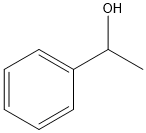| Chemical Properties |
colourless liquid |
| Definition |
ChEBI: An aromatic alcohol that is ethanol substituted by a phenyl group at position 1. |
| General Description |
A colorless liquid. Insoluble in water and less dense than water. Contact may slightly irritate skin, eyes and mucous membranes. May be slightly toxic by ingestion, inhalation and skin absorption. Used to make other chemicals. |
| Air & Water Reactions |
Insoluble in water. |
| Reactivity Profile |
Attacks plastics. [Handling Chemicals Safely, 1980. p. 236]. Acetyl bromide reacts violently with alcohols or water [Merck 11th ed. 1989]. Mixtures of alcohols with concentrated sulfuric acid and strong hydrogen peroxide can cause explosions. Example: An explosion will occur if dimethylbenzylcarbinol is added to 90% hydrogen peroxide then acidified with concentrated sulfuric acid. Mixtures of ethyl alcohol with concentrated hydrogen peroxide form powerful explosives. Mixtures of hydrogen peroxide and 1-phenyl-2-methyl propyl alcohol tend to explode if acidified with 70% sulfuric acid [Chem. Eng. News 45(43):73. 1967; J, Org. Chem. 28:1893. 1963]. Alkyl hypochlorites are violently explosive. They are readily obtained by reacting hypochlorous acid and alcohols either in aqueous solution or mixed aqueous-carbon tetrachloride solutions. Chlorine plus alcohols would similarly yield alkyl hypochlorites. They decompose in the cold and explode on exposure to sunlight or heat. Tertiary hypochlorites are less unstable than secondary or primary hypochlorites [NFPA 491 M. 1991]. Base-catalysed reactions of isocyanates with alcohols should be carried out in inert solvents. Such reactions in the absence of solvents often occur with explosive violence [Wischmeyer 1969]. |
| Health Hazard |
Irritating to the skin, eyes, nose, throat, and upper respiratory tract. |
| Fire Hazard |
Combustible material: may burn but does not ignite readily. When heated, vapors may form explosive mixtures with air: indoors, outdoors and sewers explosion hazards. Contact with metals may evolve flammable hydrogen gas. Containers may explode when heated. Runoff may pollute waterways. Substance may be transported in a molten form. |
| Safety Profile |
Poison by ingestion and subcutaneous routes. Moderately toxic by skin contact. A skin and severe eye irritant. Questionable carcinogen. Combustible when exposed to heat or flame; can react with oxidming materials. To fight fire, use alcohol foam, foam, CO2, dry chemical |
| Purification Methods |
Purify the alcohol via its hydrogen phthalate. [See Houssa & Kenyon J Chem Soc 2260 1930.] Shake it with a solution of ferrous sulfate, and th |

 China
China





